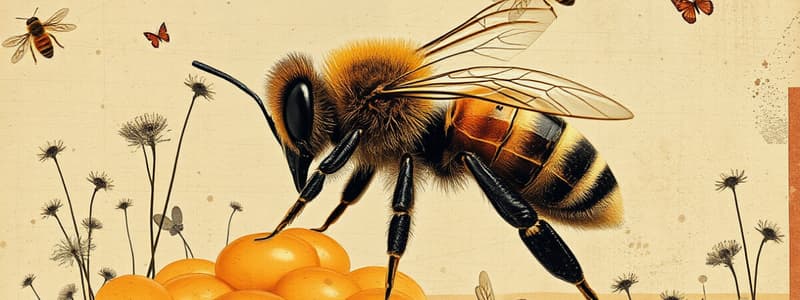Podcast
Questions and Answers
What does apiculture primarily involve?
What does apiculture primarily involve?
- The study of wild bees in their natural habitat
- The extraction of bee products from wild nests
- The observation of bees for scientific research purposes
- The practice of maintaining honeybee colonies for honey production (correct)
Which of the following innovations contributed to modern beekeeping?
Which of the following innovations contributed to modern beekeeping?
- Honeycomb harvesting tools
- Bee health monitoring systems
- Comb foundation mill (correct)
- Artificial bee feeding machines
How many species of wild bees have been described so far?
How many species of wild bees have been described so far?
- More than 20,000 species (correct)
- Over 5,000 species
- Less than 10,000 species
- Approximately 15,000 species
What type of bees does apiculture primarily focus on?
What type of bees does apiculture primarily focus on?
Which of the following statements is true regarding wild bees?
Which of the following statements is true regarding wild bees?
Flashcards are hidden until you start studying
Study Notes
History and Development of Apiculture of India
- Innovations in apiculture include the comb foundation mill, honey extractor, and smoker.
- These advancements have significantly contributed to the evolution of modern beekeeping practices.
What is Apiculture
- Defined as the scientific management of honeybee colonies by humans.
- Involves maintaining bees in hives, harvesting bee products, and marketing them professionally.
- The term is derived from the Latin word apis, meaning bee.
Wild Bees
- Over 20,000 species of wild bees have been identified by taxonomists.
- Many wild bee species are solitary, such as mason bees.
- Some species, like bumble bees, rear their young in small colonies or burrows.
Apiculture in India
- Focuses on the management of social bee species, which can have colonies of up to 100,000 individuals.
- Supports both pollination and commercial honey production.
Studying That Suits You
Use AI to generate personalized quizzes and flashcards to suit your learning preferences.




